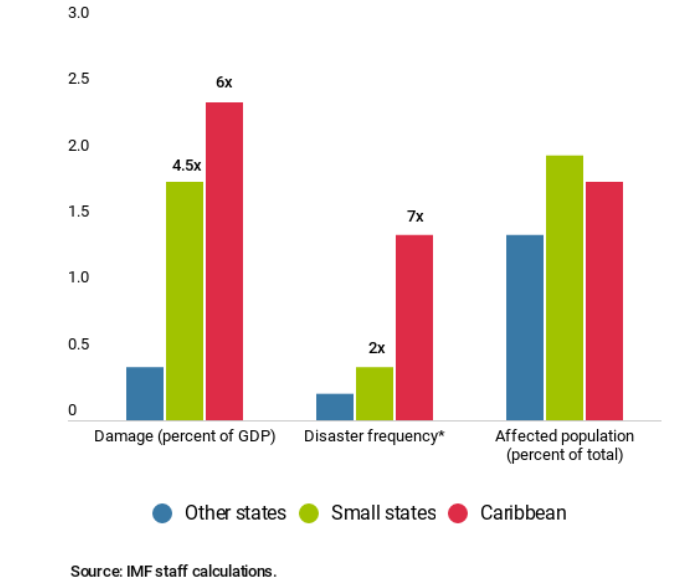Climate Change and the Labour Market
Commentary

The recent surge in catastrophic natural disasters and worldwide calamities would have forced most countries to re-evaluate economic growth models with specific emphasis on consumption and production practices. Presently, through technological and scientific advances many countries have altered their manufacturing practices to adapt to one which fosters growth and development in a more environmentally- stable, biodiverse, low-carbon and climate resilient manner. There has been a heightened consciousness among governments, businesses and the general public of the socioeconomic impact of human activities on the environment. Hence, climate change mitigation and adaption policies have been placed at the forefront of many economies’ agenda as the vulnerability in terms of natural systems have been understood. A key aspect that is often overlooked by many climate-based policies is the effect it would have on labour markets over the medium to long term.
Environmental degradation, caused by climate change and adaption policies will continue to have an unrelenting negative impact on the workforce and productivity levels, and is expected to worsen in the foreseeable future. To possess an understanding of the correlation between climate change and the labour market one has to examine how key factors such as labour productivity, unemployment, and job availability will be affected by regulatory changes to the natural and economic landscape. Sectors that depend heavily on the natural environment will be among those directly affected in terms of job availability and productivity. These sectors include agriculture, fisheries, forestry and tourism. Climate change threatens the provision of many of these vital services, as countries experience the increasing impacts of rising sea levels, supercharged storms and higher wind speed, prolonged drought and wildfire seasons and heavier precipitation and flooding. This affects the current dynamics of the labour force. Greenhouse gases trap more heat within the Earth’s atmosphere causing average temperatures to rise worldwide, this in turn causes many environmental hazards that directly affect the labour force. The resulting consequences of this are; regions and workplaces that are too hot for work, climate induced migration, reduced productivity, and higher unemployment.
Natural disasters pose a threat to infrastructure, human life and natural resources which are all linked to the labour force. Death, disabilities and infrastructural damage caused by natural disasters reduce the productive potential of the country. The International Labour Organization estimates that between 2000 and 2015 twenty-three million working life years were lost annually as a result of various environment-related hazards caused or exacerbated by human activity. This is equivalent to 0.8 percent of a year’s work, considering that 2.8 billion people ages 15-64 are employed every given year. During the period of 2008- 2015, China, Brazil and India were the most affected countries, with, respectively, 8.7,3.2 and 1.5 working-life years lost per person per year.
According to the International Labour Organization (ILO), in 2014 1.2 billion jobs, accounting for 40 percent of the total world employment, were in industries that are heavily dependent on the ecosystem. The direct impact on these industries because of climate change has a domino effect on the entire economy in terms of upstream and downstream industries. Industries that provide raw material inputs to others are typically based on natural resources. Disruptions in these industries indirectly affects employment and productivity in sectors that depend on their inputs. When the provision of raw materials is affected as a result of ecosystem disruptions, dependent industries will have to operate at a lower capacity producing less output than is demanded by the upstream industries hence, affecting additional jobs. The linkage can be seen within the Agricultural industry, when yields are affected by temperature, increased flooding, reduction in water availability, and change in precipitation patterns, in turn affects the transportation industry, manufacturing and processing industry and the service industry. Decreased output would in turn lead to downsizing and lower profit margin which inevitably affects employment levels.
Being one of regions in the world most reliant on the tourism sector, the Caribbean regional labour market is particularly vulnerable to the effects of climate change. The sector is vital to the economy and the livelihoods of its citizens. However, with low-lying coastal areas, and susceptibility to natural disasters, jobs are at a higher risk. According to the International Organization (ILO), in 2019 approximately, four hundred and thirteen thousand (413,000) persons were directly employed in the tourism sector in the Caribbean. Tourism workers in the region are faced with unemployment, underemployment and a loss of income as result of the effects of climate change on the natural environment. Climate determines the length and quality of the tourism season, which is an important driver in tourism demand as the natural environment can be affected in ways that can attract or deter visitors. For example, a rise in sea levels and temperature leads to coastal erosion, loss of beach area, increased coral bleaching and aesthetic degradation which may significantly deter tourists and drastically decrease the demand for employment within this sector. Natural disasters are becoming more vicious and frequent which affect tourism- related infrastructure. Category 5 hurricanes Maria and Irma are clear depictions of how powerful storms can lead to widespread destruction. As hotels and guesthouses are destroyed it reduces the stay-over capacity and reduces tourism receipts. A specific regional example of the costs attached to climate change is Dominica. Being a tourism dependent nation, destruction of infrastructure amounted to damages costing about 226% of GDP. The cost attached to major sectors in Eastern Caribbean Dollars (ECD) are as follows; Agriculture (485 million), Transportation (633.91 million), Housing (1032 million), Tourism (245 million), Fisheries (14.39 million), and Forestry (80.24 million). At the time, the IMF estimated that reconstruction efforts would take upwards to five years. Given their focus on tourism many citizens faced a lack of alternative employment opportunities given their skillset. The result was a spike in Dominican unemployment.
The Caribbean being highly susceptible to the negative effects of climate change on their ecosystem must focus on mitigation and adaption polices which would encourage a broader support system and funding. Adaptation and preventative measures would reduce vulnerabilities in terms of recovery initiatives, further damage to infrastructure, development, and human resources. Given the vulnerabilities of the region, governments have affirmed their position to reduce carbon emission levels as it relates to the Paris Agreement. The Paris agreement’s central aim is to strengthen the global response to global temperature rise in this century to well below 2 degrees Celsius above pre-industrial levels and to pursue efforts to limit the temperature increase further to 1.5 degrees Celsius. Secondly, develop and strengthen coastal locations, urban infrastructure and biodiversity preservation programs. The area that leaves room for improvement to achieve sustainable development lies in policies as it relates to the labour market, particularly, measures that monitor and hold accountable countries to honour and maintain their pledges to stick to carbon emission levels determined by Paris Agreement as this would directly affect employment prospects in the region. Public and private sector partnerships along with community support can be promoted in the installation and development of resilient, sustainable infrastructure as well as biodiversity preservation initiatives in the at-risk coastal communities. This would in turn lead to both job preservation and job creation along with increased foreign investment opportunities. Lastly, increased intra-Caribbean cooperation in disaster-risk management and response programs coupled with the formulation of adaptation policies will foster a faster recovery time thus reducing the economic effect of the country.
Figure 1: Comparison of Caribbean Islands vulnerability to natural disasters
(Frequency and effects of natural resources 1990-2014)

Understanding the dynamics of how the labour market is significantly affected by climate change and implementing proper policies and procedures will minimise the risk and maximise the benefits as the countries seeks to transition into low carbon economies. The labour market is expected to be redefined in the near future with emerging sectors, job creation, job loss and increased investment in training and skill development programs all in the name for long term sustainability and a greener tomorrow.
DISCLAIMER
First Citizens Bank Limited (hereinafter “the Bank”) has prepared this report which is provided for informational purposes only and without any obligation, whether contractual or otherwise. The content of the report is subject to change without any prior notice. All opinions and estimates in the report constitute the author’s own judgment as at the date of the report. All information contained in the report that has been obtained or arrived at from sources which the Bank believes to be reliable in good faith but the Bank disclaims any warranty, express or implied, as to the accuracy, timeliness, completeness of the information given or the assessments made in the report and opinions expressed in the report may change without notice. The Bank disclaims any and all warranties, express or implied, including without limitation warranties of satisfactory quality and fitness for a particular purpose with respect to the information contained in the report. This report does not constitute nor is it intended as a solicitation, an offer, a recommendation to buy, hold, or sell any securities, products, service, investment or a recommendation to participate in any particular trading scheme discussed herein. The securities discussed in this report may not be suitable to all investors, therefore Investors wishing to purchase any of the securities mentioned should consult an investment adviser. The information in this report is not intended, in part or in whole, as financial advice. The information in this report shall not be used as part of any prospectus, offering memorandum or other disclosure ascribable to any issuer of securities. The use of the information in this report for the purpose of or with the effect of incorporating any such information into any disclosure intended for any investor or potential investor is not authorized.
DISCLOSURE
We, First Citizens Bank Limited hereby state that (1) the views expressed in this Research report reflect our personal view about any or all of the subject securities or issuers referred to in this Research report, (2) we are a beneficial owner of securities of the issuer (3) no part of our compensation was, is or will be directly or indirectly related to the specific recommendations or views expressed in this Research report (4) we have acted as underwriter in the distribution of securities referred to in this Research report in the three years immediately preceding and (5) we do have a direct or indirect financial or other interest in the subject securities or issuers referred to in this Research report.
